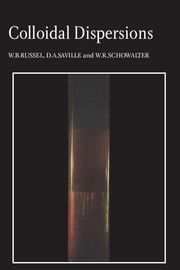Book contents
- Frontmatter
- ACKNOWLEDGEMENTS
- Contents
- Preface
- Units and physical constants
- Mathematical symbols
- 1 A Survey of Colloidal Dispersions
- 2 Hydrodynamics
- 3 Brownian Motion
- 4 Electrostatics
- 5 Dispersion forces
- 6 Forces due to soluble polymer
- 7 Electrokinetic phenomena
- 8 Electrostatic stabilization
- 9 Polymeric stabilization
- 10 Equilibrium phase behavior
- 11 Particle capture
- 12 Sedimentation
- 13 Diffusion
- 14 Rheology
- Appendix A Measured properties
- Appendix B Vector and tensor notation
- Author index
- Subject index
6 - Forces due to soluble polymer
Published online by Cambridge University Press: 05 August 2012
- Frontmatter
- ACKNOWLEDGEMENTS
- Contents
- Preface
- Units and physical constants
- Mathematical symbols
- 1 A Survey of Colloidal Dispersions
- 2 Hydrodynamics
- 3 Brownian Motion
- 4 Electrostatics
- 5 Dispersion forces
- 6 Forces due to soluble polymer
- 7 Electrokinetic phenomena
- 8 Electrostatic stabilization
- 9 Polymeric stabilization
- 10 Equilibrium phase behavior
- 11 Particle capture
- 12 Sedimentation
- 13 Diffusion
- 14 Rheology
- Appendix A Measured properties
- Appendix B Vector and tensor notation
- Author index
- Subject index
Summary
Introduction
The preceding chapters address interactions between colloidal particles dispersed in pure liquid or electrolyte solution. The hydrodynamic and dispersion forces depend only on the bulk properties of the individual phases, i.e. the viscosity and the dielectric permittivities. Electrostatic forces arising from the surface charges, however, are accompanied by free electrolyte. The associated electric fields distribute these additional species non-uniformly in the surrounding fluid, thereby producing a spatially varying osmotic pressure. Electrostatic interactions between particles alter these ion distributions, affecting the electric and pressure fields and generating an interparticle force.
We now consider another component commonly present in colloidal systems, soluble polymer. In many ways, the phenomena and the theoretical treatment resemble those for electrostatics. The interactions between polymer and particle generate non-uniform distributions of polymer throughout the solution. Particle–particle interactions alter this equilibrium distribution, producing a force whose sign and magnitude depend on the nature of the particle–polymer interaction. The major difference from the ionic solutions lies in the internal degrees of freedom of the polymer, which necessitate detailed consideration of the solution thermodynamics.
The reasons for adding soluble polymer to colloidal dispersions are several. The earliest known role, as stabilizer, aids or preserves the dispersion through adsorption of the macromolecule onto the surfaces of the particles to produce a strongly repulsive interaction. Homopolymers achieve this by adsorbing to particles non-specifically at multiple points along their backbone, while block or graft copolymers adsorb irreversibly at one end with the other remaining in solution (Napper, 1983).
Information
- Type
- Chapter
- Information
- Colloidal Dispersions , pp. 162 - 210Publisher: Cambridge University PressPrint publication year: 1989
Accessibility standard: Unknown
Why this information is here
This section outlines the accessibility features of this content - including support for screen readers, full keyboard navigation and high-contrast display options. This may not be relevant for you.Accessibility Information
- 1
- Cited by
